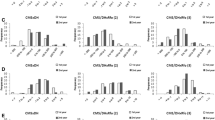Summary
Considerable heterosis has been demonstrated in inter-cultivar swede hybrids. Increases in dry matter yield of between 5.9 and 25.6% over the superior parent were obtained. Difficulties and possibilities with regard to the commercial exploitation of this phenomenon in swedes are discussed.
Similar content being viewed by others
References
Chowdhury, J. B. & Das, K., 1966. Male sterility in yellow sarson. Indian J. Genet. Pl. Breed. 26: 374–380.
Davey, V. McM., 1932. The method of sampling swede bulbs by cores. J. agric. Sci., Camb. 22: 767–782.
Davey, V. McM. & Lang, J. M. S., 1938. Root crops (swedes and kales). Rep. Scott. Soc. Res. Pl. Breed. 1938: 28–31.
Frandsen, K. J., 1958. Breeding of swede (B. napus var. rapifera L.). Handb. PflZücht. 3: 311–326.
Johnson, A. G., 1958. Male sterility in Brassica. Nature, Lond. 182: 1523.
Johnston, T. D., 1963. Inbreeding and hybrid production in marrow-stem kale Brassica oleracea L. var. acephala D.C.. I. The effects of inbreeding and the performance of F1 hybrids. Euphytica 12: 198–204.
Johnston, T. D., 1971. A comparison of inbred lines and their F1 hybrids in forage rape (Brassica napus L.). Euphytica 20: 81–85.
Josefsson, A., 1948. Breeding of root crops. In: A., Akerman, O., Tedin, K., Fröier & R. O., Whyte (Ed.), Svalöf 1896–1946, p. 148–165. Carl Bloms Boktryckeri A.-B. Lund.
Koch, H. & Peters, R., 1953. Nue Gesichtspunkte der Rapzüchtung. Wiss. Z. Martin-Luther-Univ. Halle-Wittenb. 2: 363–367.
Nakagawa, H., Kamimura, S. & Sato, I., 1955. (Studies on breeding Brassica pekinensis. I. Hybrid vigour in varietal and strain crosses.) Rep. Tôhoku natn. agric. Exp. Stn 1955: No 4: 133–151.
Nieuwhof, M., 1961. Male sterility in some cole crops. Euphytica 10: 251–356.
Olsson, G., 1955. Heterosis hos varrybs. (Heterosis in spring turnip rape). Sver. Utsädesför. Tidskr. 65: 215–219.
Olsson, G., 1960a. Self-incompatibility and outcrossing in rape and white mustard. Hereditas 46: 241–252.
Olsson, G., 1960b. Species crosses within the genus Brassica. II. Artificial Brassica napus L. Hereditas 46: 351–386.
Palmer, T. P., 1962. Population structure, breeding system, interspecific hybridization and allopolyploidy. Heredity 17: 278–283.
Pearson, O. H., 1931. The influence of inbreeding upon the season of maturity in cabbage. Proc. Am. Soc. hort. Sci. 28: 359–366.
Rasmusson, J., 1932. Results from a cross cabbage x savoy cabbage. Hereditas 16: 241–248.
Sampson, D. R., 1966. Linkage of genetic male sterility with a seedling marker and its use in producing F1 hybrid seed of Brassica oleracea (cabbage, broccoli, kale etc.), Can. J. Pl. Sci. 46: 703.
Swarup, V., Gill, H. S. & Singh, D. 1963. Studies on hybrid vigour in cabbage. Indian J. Genet. Pl. Breed. 23: 90–100.
Thompson, K. F., 1959. Breeding better kales. Agriculture, Lond. 65: 487–491.
Thompson, K. F., 1968. Classified S alleles for Brassida breeders. In: G. E. Dixon (Ed.), Proc. Brassica Meet. Eucarpia (Sept. 1968), pp. 65.
Tokumasu, S., 1951. Male sterility in Japanese radish (Raphanus sativus L.). Scient. Bull. Fac. Agric. Kyushu Univ. 13: 83–89.
U.N., 1935. Genome analysis in Brassica with special reference to the experimental formation of B. napus and peculiar mode of fertilization. Jap. J. Bot. 7: 389–452.
Wit, F., 1960. Chemically induced male sterility, a new tool in plant breeding? Euphytica 9: 1–9.
Yamaguchi, T. & C. Kanno, 1963. (Studies on differences in expression of characters in direct and reciprocal crosses of rape. VI. Cytohistological observations on the course of development of the floral organs in the F1 of direct and reciprocal crosses.) Bull. 1st Agron. Div. Tokai-Kinki natn. agric. Exp. Stn No 9: 162–182.
Zeevaart, J. D., 1955. Heterosis in Brussels sprouts, especially with reference to cold resistance. Euphytica 4: 127–132.
Author information
Authors and Affiliations
Rights and permissions
About this article
Cite this article
McNaughton, I.H., Munro, I.K. Heterosis and its possible exploitation in swedes (Brassica napus L. ssp. rapifera). Euphytica 21, 518–522 (1972). https://doi.org/10.1007/BF00039349
Received:
Issue Date:
DOI: https://doi.org/10.1007/BF00039349



